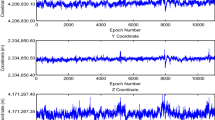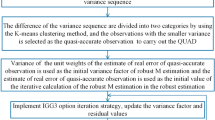Abstract
The proper identification and removal of outliers in the combination of rates of vertical displacements derived from GPS, tide gauges/satellite altimetry, and GRACE observations is presented. Outlier detection is a necessary pre-screening procedure in order to ensure reliable estimates of stochastic properties of the observations in the combined least-squares adjustment (via rescaling of covariance matrices) and to ensure that the final vertical motion model is not corrupted and/or distorted by erroneous data. Results from this study indicate that typical data snooping methods are inadequate in dealing with these heterogeneous data sets and their stochastic properties. Using simulated vertical displacement rates, it is demonstrated that a large variety of outliers (random scattered and adjacent, as well as jointly influential) can be dealt with if an iterative re-weighting least-squares adjustment is combined with a robust median estimator. Moreover, robust estimators are efficient in areas weakly constrained by the data, where even high quality observations may appear to be erroneous if their estimates are largely influenced by outliers. Four combined models for the vertical motion in the region of the Great Lakes are presented. The computed vertical displacements vary between − 2 mm/year (subsidence) along the southern shores and 3 mm/year (uplift) along the northern shores. The derived models provide reliable empirical constraints and error bounds for postglacial rebound models in the region.
Similar content being viewed by others
References
Baarda W (1968) A testing procedure for use in geodetic networks. In: Netherlands Publications on Geodesy, vol 2, no. 5. Deflt, The Netherlands, pp 97
Barbarella M, Mussio L (1985) A strategy for identification of outliers in geodetic sciences. In: Statistic and Decisions, supplement issue no. 2. R Oldenbourg, Verlag, Monaco
Barnett V, Lewis T (1978) Outliers in statistical data. Wiley, New York
Bettadpur S (2004) Gravity recovery and climate experiment, level-2 gravity field product user handbook. Center for Space Research, The University of Texas at Austin
Crocetto N, Gatti M, Russo P (2000) Simplified formulae for the BIQUE estimation of variance components in disjunctive observation groups. J Geod 74: 447–457
Dollinger MB, Staudte RG (1991) Influence functions of iteratively reweighted least squares estimators. J Am Stat Assoc 86(415)
Fotopoulos G (2005) Calibration of geoid error models via a combined adjustment of ellipsoidal, orthometric and gravimetric geoid height data. J Geod 79: 111–123
Haagmans RHN, van Gelderen M (1991) Error variances–covariances of GEM-T1: their characteristics and implications in geoid computation. J Geophys Res 96(B12): 20011–20022
Hardy RL (1977) The application of multiquadric equations and point mass anomaly models to crustal movement studies. Report National Research Council. National Academy of Science, Washington, DC
Hekimoğlu S (1997) Finite sample breakdown points of outlier detection procedures. J Surv Eng 123(1): 15–31
Hekimoğlu S, Berber M (2003) Effectiveness of robust methods in heterogeneous linear models. J Geod 76: 706–713
Kern M, Preimesberger T, Allesch M, Pail R, Bouman J, Koop R (2005) Outlier detection algorithms and their performance in GOCE gravity field processing. J Geod 78: 509–519
Koch K-R (1999) Parameter estimation and hypothesis testing in linear models, 2nd edn. Springer, Berlin
Kuo CY, Shum CK, Braun A, Cheng KC, Yi Y (2008) Vertical motion determined by using satellite altimetry and tide gauges. Terr Atmos Ocean Sci (in press)
Mainville A, Craymer M (2005) Present-day tilting of the Great Lakes region based on water level gauges. GSA Bull 117(7-8): 1070–1080
Park K-D, Nerem RS, Davis JL, Schenewerk MS, Milne GA, Mitrovica JX (2002) Investigation of glacial isostatic adjustment in northeast U.S. using GPS measurements. Geophys Res Lett 29(11): 1509. doi:10.1029/2001GL013782
Paulson A, Zhong S, Wahr J (2007) Limitations on the inversion for mantle viscosity from postglacial rebound. Geophys J Int 168: 1195–1209
Peltier WR (1994) Ice-age paleotopography. Science 265: 195–201
Peltier WR (2004) Global glacial isostasy and the surface of the ice-age earth: the ICE-5G (VM2) model and GRACE. Annu Rev Earth Planet Sci 32: 111–149
Pope AJ (1976) The statistics of residuals and the detection of outliers. NOAA Tech. Rep. NOS 65 NGS 1, US Department of Commerce, Rockville
Rangelova E (2007) A dynamic geoid model for Canada. Ph.D thesis, University of Calgary, Department of Geomatics Engineering, Report no. 20261
Rangelova E, Sideris MG (2008) Contributions of terrestrial and GRACE data to the study of the secular geoid changes in North America. J Geodyn. doi:10.1016/j.jog.2008.03.006
Rangelova E, van der Wal W, Braun A, Sideris MG, Wu P (2007) Analysis of GRACE time-variable mass redistribution signals over North America by means of principal component analysis. J Geophys Res 112: F03002. doi:10.1029/2006JF000615
Rodell M, Houser PR, Jambor U, Gottschalck J, Mitchell K, Meng CJ, Arsenault K, Cosgrove B, Radakovich J, Bosilovich M, Entin JK, Walker JP, Lohmann D, Toll D (2004) The global land data assimilation system. Bull Am Meteorol Soc 85(3): 381–394
Rousseeuw PJ, Croux C (1993) Alternatives to the median absolute deviation. J Am Stat Assoc 88(424): 1273–1283
Sella GF, Stein S, Dixon TH, Craymer M, James TS, Mazzotti S, Dokka RK (2007) Observation of glacial isostatic adjustment in “stable” North America with GPS. Geophys Res Lett 34: L02306. doi:10.1029/2006GL027081
Swenson S, Wahr J (2006) Post-processing removal of correlated errors in GRACE data. Geophys Res Lett 33. doi:10.1029/2005GL025285
Tapley BD (1997) The gravity recovery and climate experiment (GRACE). EOS Trans Am Geophys Union Suppl 79(46)
Tushingham AM (1992) Postglacial uplift predictions and historical water levels of the Great Lakes. J Great Lakes Res 18(3): 440–455
Vander Wal W, Schotman HHA, Vermeersen LLA (2004) Geoid heights due to a crustal low viscosity zone in glacial isostatic adjustment modeling: a sensitivity analysis. GOCE Geophys Res Lett 31: L05608. doi:10.1029/2003GL019139
Wahr J, DaZhong H, Trupin A (1995) Prediction of vertical uplift caused by changing polar ice volume on a viscoelastic Earth. Geophys Res Lett 22: 977–980
Wahr J, Molenaar M, Bryan F (1998) Time variability of the Earth’s gravity field: Hydrological and oceanic effects and their possible detection using GRACE. J Geophys Res 103(B12): 30205–30229
Wahr J, Wingham D, Bentley C (2000) A method of combining ICESat and GRACE satellite data to constrain Antarctic mass balance. J Geophys Res 105(B7): 16279–16294
Yang Y (1994) Robust estimation for dependent observations. Manuscr Geod 19: 10–17
Author information
Authors and Affiliations
Corresponding author
Rights and permissions
About this article
Cite this article
Rangelova, E., Fotopoulos, G. & Sideris, M.G. On the use of iterative re-weighting least-squares and outlier detection for empirically modelling rates of vertical displacement. J Geod 83, 523–535 (2009). https://doi.org/10.1007/s00190-008-0261-6
Received:
Accepted:
Published:
Issue Date:
DOI: https://doi.org/10.1007/s00190-008-0261-6




